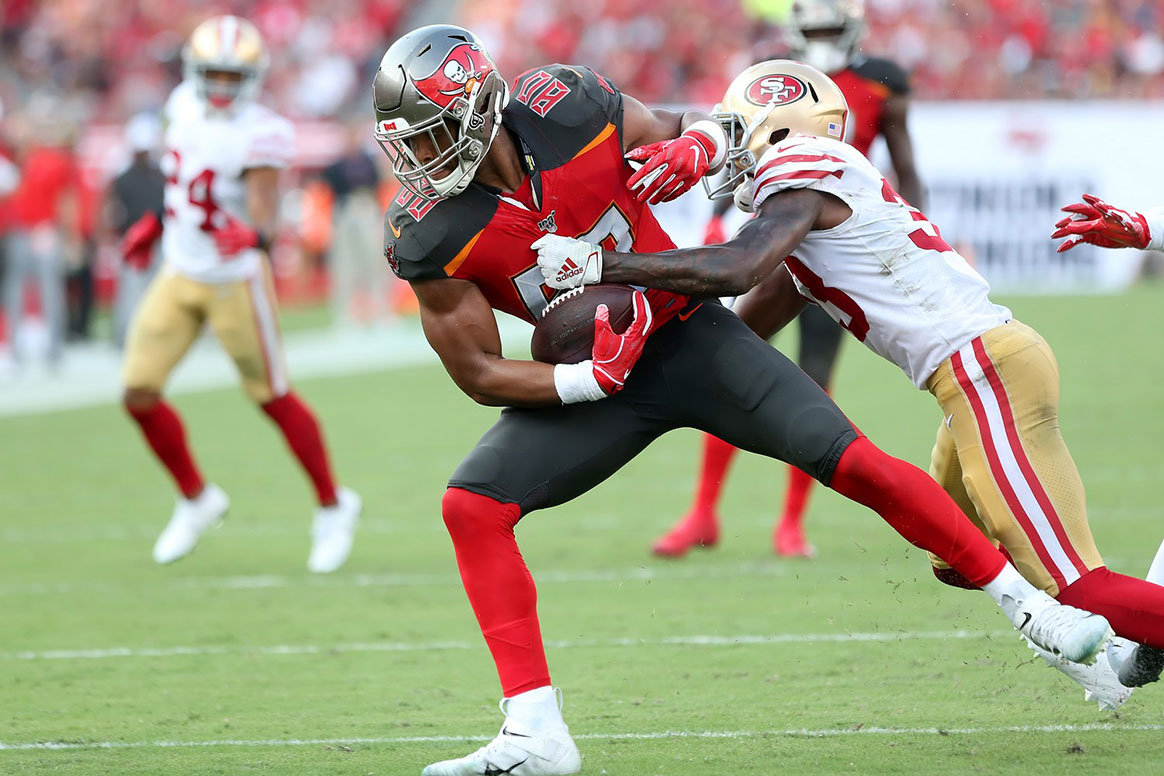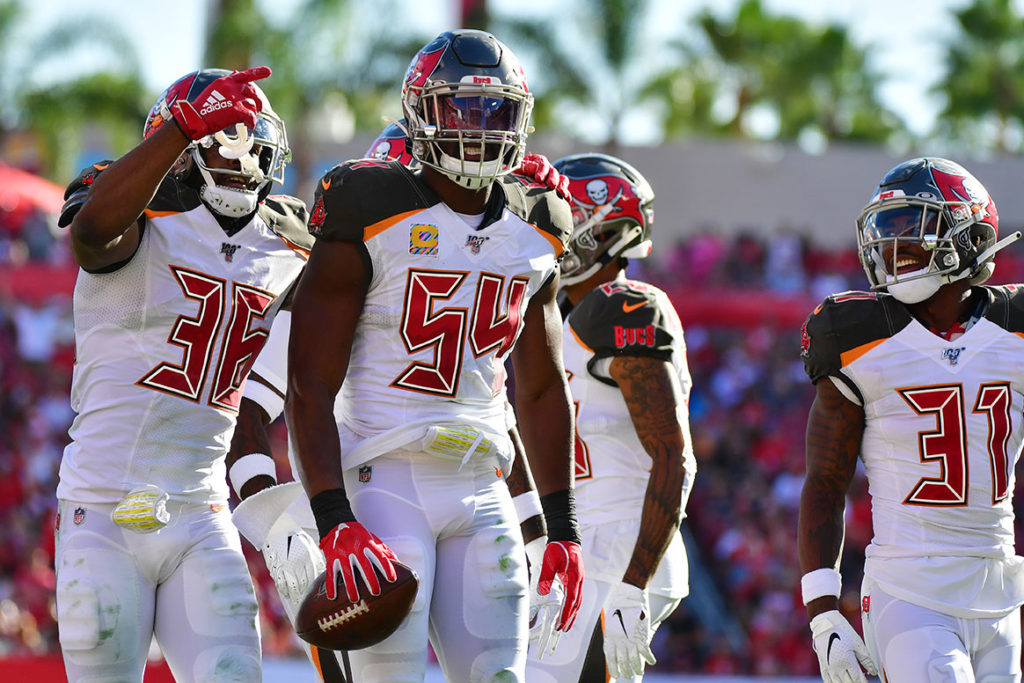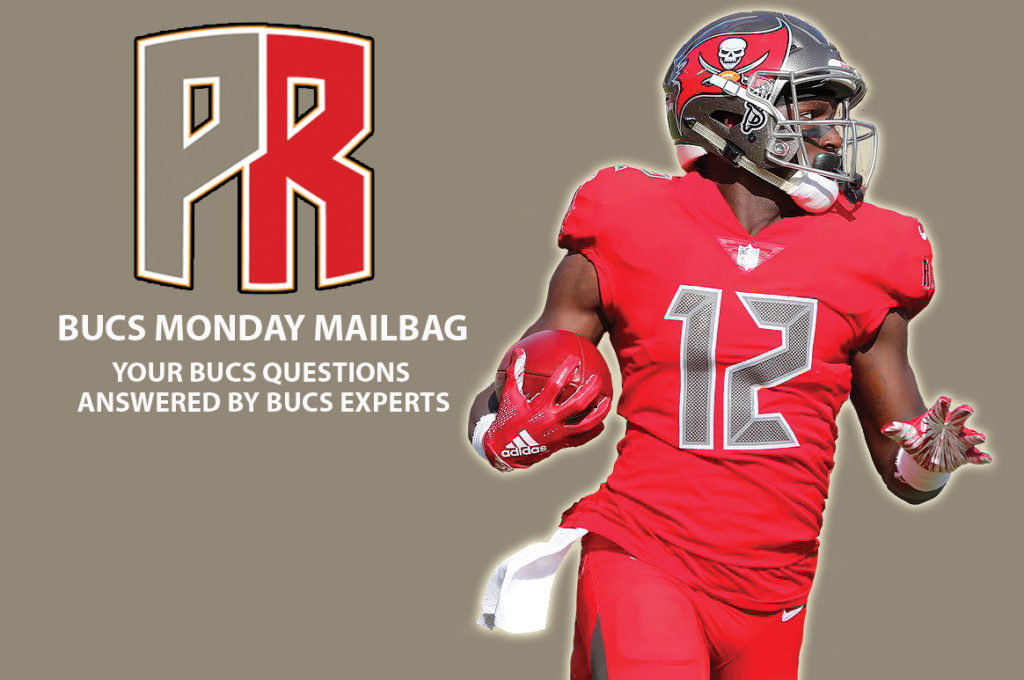It would be naive to expect a full identity change from the Bucs offense in 2020, but the addition of Tom Brady and Rob Gronkowski, as well as the loss of No. 3 wide receiver Breshad Perriman, could increase the team’s usage of two tight end sets significantly.
Last season the Bucs spent 23 percent of their snaps in 12 personnel (one running back, two tight ends), the 8th-highest mark in the league according to Sharp Football Stats. With O.J. Howard and Cameron Brate in the fold, that number probably would have at least held strong going into 2020, but the presence of Gronkowski could suggest an even bigger shift in the team’s number of two-tight end looks.
With three quality tight ends on the roster and no proven No. 3 wide receiver, the Bucs have one of the more oddly constructed receiving rooms in the entire league. No team in the NFL can boast their quality of depth at tight end, but the Bucs may also have the weakest competition for their No. 3 wide receiver spot across any of the other 31 rosters.
If you read last week’s Bucs Briefing, you know that NFL Films’ Greg Cosell is a brilliant football mind. So brilliant in fact, that he gave me over two full pages of quotes, thoughts and film observations on the Bucs offense that I didn’t even get to include in last week’s piece. So I’ll borrow some from Greg again as we break down the Bucs upcoming 12 personnel looks.
“I think much of (the tight ends role in the passing game) will depend on who ends up being the third receiver,” Cosell said. “At the end of the day, you want to put your best weapons out on the field. If you don’t feel like, whether it’s Scotty Miller or Tyler Johnson or someone else at wide receiver, is ultimately going to be quite good enough to get meaningful snaps, you’ve clearly got three tight ends who can play.”
Third-year receiver Justin Watson will likely begin training camp as the team’s No. 3, but although he showed some promise this past season, the Penn product’s 15 career catches aren’t much to go on. Former sixth round pick Scotty Miller offers 13 receptions, while fifth-round pick Tyler Johnson is the favorite to eventually take over the job. How quickly that will happen for the rookie remains to be seen however.
In the meantime, although Cameron Brate’s production has fallen off some the past two seasons, he’ll enter the 2020 campaign as arguably the best No. 3 tight end across the entire league. Combine his reliable and polished short-intermediate game with O.J. Howard’s league-leading yards per reception and yards per target numbers for the tight end position since he entered the league three years ago, and you can see why the Bucs would be running a healthy amount of 12 personnel regardless of the presence of Gronkowski.
“I’ve always been a big Cameron Brate fan,” Cosell said. “I think he’s a really good player. He’s another one of those guys that is almost like a big wide receiver. So they’ve got three tight ends that can move. I wouldn’t call O.J. Howard nuanced. He’s somewhat straight-line and linear, but he’s got plus speed and some explosiveness to him. So I think that will depend on the development of Tyler Johnson and the development of Miller to determine what the breakdown of personnel packages are, and how Brady feels about that. We know Brady is very comfortable in 12 personnel. If he has good 12 personnel, he’s very, very comfortable in that.”
That’s perhaps the most compelling aspect of all of this: not only are the Bucs loaded at tight end, but they are also currently rostering the best quarterback in modern NFL history out of 12 personnel. From Gronk and Aaron Hernandez to Gronk and Martellus Bennett to less talented, yet still mildly productive duos early in Brady’s New England tenure, the Patriots were always among the league leaders working from two tight end sets.
“That’s where Brady’s experience with (Bill) Belichick and the use of 12 personnel comes into play,” Cosell said. “The Patriots were as good as any team in the league, probably the Patriots and the Saints with Sean Payton, at being formation multiple out of 12 personnel. How many times have we seen the Patriots or the Saints go to empty out of 12?
“You pretty much know from film study how the defense will react to that. More often than not defenses will play zone against that. Now, if they want to match up man-to-man when you’re in 12 personnel offensively, if it’s a normal down-and-distance situation, the defense is going to be in their base with only four defensive backs on the field. So now, you have an advantage. You put Gronkowski and Howard out there as your two tight ends and go spread, go empty, and now you’ve got (Chris) Godwin and (Mike) Evans out there, I think a lot of defenses are going to go to zone, don’t you? How are you going to match up in base to – forget Gronkowski – even Howard? He’s not nuanced, but he can run.”
There are simply so many ways that Tampa Bay can attack teams out of 12 personnel. As Cosell mentions, the pure logistics of even matching up appropriately with the Bucs personnel out of 12 are extremely challenging for the majority of NFL defenses. If you match with base defense in man coverage, your linebackers are going to be forced to deal with either Gronkowski or Howard or both in coverage. You also could become predictable with your safety shells, re-signed to single high looks as the strong safety is forced to come down over the slot to deal with the athleticism of the Bucs top two tight ends.
“This is where Brady is brilliant,” Cosell said. “If a team’s default is Cover 3, you’re going to get seam throws. If a team’s default is to play 2-shell (two high safeties), whether it’s quarters or two, you’re gonna get a lot of high-low concepts. It’s pre-defined for him before the snap of the ball.”
If team’s want to match the Bucs 12 personnel package with Cover 1 (man with a single-high safety) or Cover 3 out of their base defense, expect plenty of seam throws from Brady, as he puts the single-high safety in a bind with his eye movement and forces linebackers to carry vertically, before ripping one down the hashes to two of the best seam-running tight ends in the game. He and Gronkowski have made a Hall of Fame living off their connection in that area of the field, while Howard has continually flashed his best ball on similar patterns.
The other thing to be aware of in single-high defenses, especially out of base, is that they make it much harder to double any receiver. That means Mike Evans will be working heavily against single coverage looks, a dream scenario for any receiver who wins primarily down the field. Around midfield, the Bucs should readily take shots out of 12 personnel, catching defenses in a tough bind if they choose to play their base personnel. Expect Evans to have plenty of winnable matchups on the outside as a result.
“There will be called shot plays that often come out of 12 personnel,” Cosell said. “Brady can throw those, anybody can throw those because those are schemed plays. Bruce has been doing this a long time. I know it was an easy narrative when they signed Brady to say ‘oh, the offenses don’t mix! Bruce is no risk it, no biscuit, he just wants to chuck it down the field, and Brady isn’t that guy’. Well, no. Bruce is not an idiot. He’s been doing this a long time. So there will be a mix and match between what Bruce likes to do and what Brady is really comfortable with. It’s like when Adam Gase became the OC with Peyton Manning. You kind of mix and match.”
If opposing defenses try to counter the Bucs 12 personnel with a big nickel or dime look, the Bucs could gash opponents in the run game. Smaller defensive personnel doesn’t put you at an inherent disadvantage, but your defensive backs better know their run fits and reads or it could be a long afternoon.
One of the most important principles of a sound inside run game, where the Bucs focused their rushing attack last season, is the ability to get defenders out of the box. Because of the vertical threat of Gronkowski and Howard’s skills sets, they’re perfect candidates to flex out from an in-line position and bring opponents with them. That’ll leave plenty of 6-man boxes for Tampa to run into, which is how they’ll find the success that eluded them on the ground a season ago.
Cosell is right that whether opponents are in base or nickel or dime, some type of zone defense or matchup zone defense will likely be the method teams eventually turn to in order to slow down the Bucs offense. Brady has shredded basic zone defenses for years and Chris Godwin is a middle-of-the-field monster vs. zone, so the onus will be on opponents to mix up their secondary looks, disguise things pre-snap and play more complicated matchup coverages that force the Bucs out of their typical methods of attack.
That sounds fine on paper, but it means the Bucs’ offense will force every defense to prepare heavily throughout the week, needing better execution than normal on Sundays. Brady won’t see all the two-high shells he saw last season in New England if the Bucs can threaten teams out of 12 personnel, and even if he does, his weaponry is one hundred times more superior than in 2019. Matching up with all the Bucs talent when they have two tight ends on the field, both schematically and individually, will keep many defensive coordinators up at night this season. There simply isn’t a great way to do it on paper unless your defensive secondary talent is among the league’s best.
Jon Ledyard is PewterReport.com's newest Bucs beat writer and has experience covering the Pittsburgh Steelers as a beat writer and analyzing the NFL Draft for several draft websites, including The Draft Network. Follow Ledyard on Twitter at @LedyardNFLDraft




